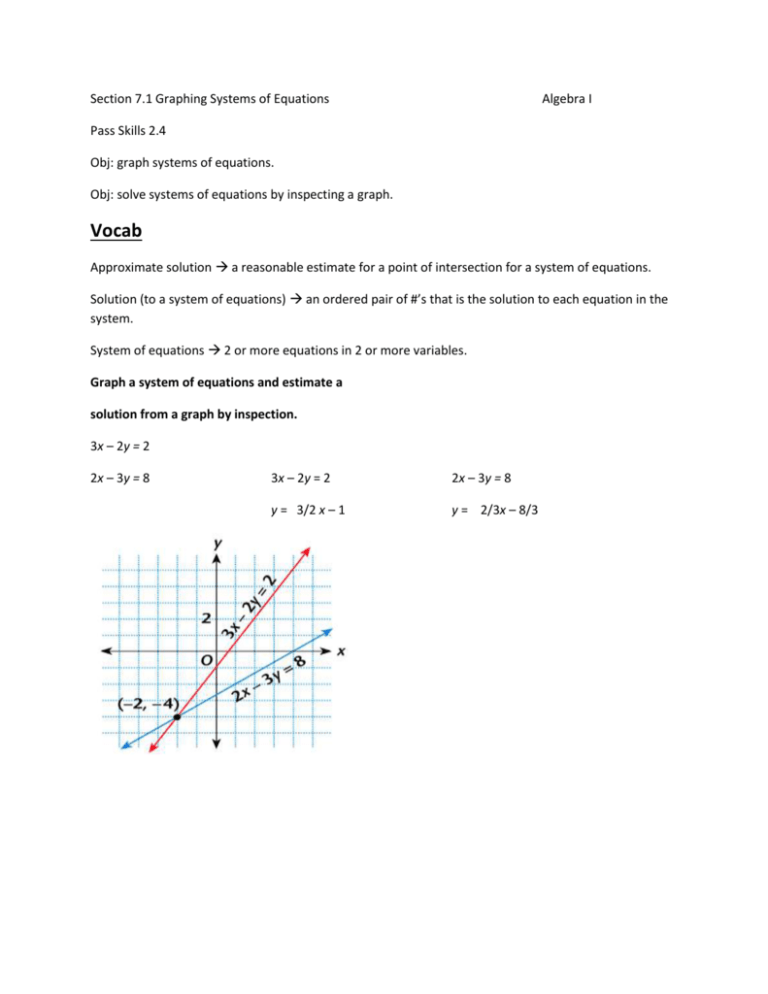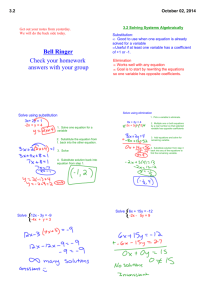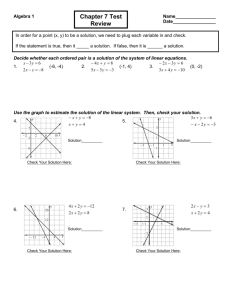Document
advertisement

Section 7.1 Graphing Systems of Equations Algebra I Pass Skills 2.4 Obj: graph systems of equations. Obj: solve systems of equations by inspecting a graph. Vocab Approximate solution a reasonable estimate for a point of intersection for a system of equations. Solution (to a system of equations) an ordered pair of #’s that is the solution to each equation in the system. System of equations 2 or more equations in 2 or more variables. Graph a system of equations and estimate a solution from a graph by inspection. 3x – 2y = 2 2x – 3y = 8 3x – 2y = 2 2x – 3y = 8 y = 3/2 x – 1 y = 2/3x – 8/3 Section 7.2 The Substitution Method Algebra I Obj: Find an exact solution to a system of linear equations by using the substitution method. Vocab Substitution method a method used to solve a system of equations in which variables are replaced with known values or algebraic expressions. Find an exact solution to a system of equations by using the substitution method. Solve the first equation for x. x+y=7 x = –y + 7 Substitute for x in the second equation and solve for y. x + 2y = –1 (–y + 7) + 2y = –1 7 + 2y – y = –1 7 + y = –1 y = –8 ** substitute -8 in for y and solve for x to get an exact solution. x-8 =7 x = 15 The solution is (15, –8). Section 7.3 The Elimination Method Algebra I Pass Skills 2.4 Obj: use the elimination method to solve a system of equations. Obj: choose an appropriate method to solve a system of equations. Vocab Elimination method a method used to solve a system of equations in which one variable is eliminated by adding opposites. Solve using elimination. *** elimination is used here because it is very easy to eliminate the y. *** elimination*** the b’s can be easily eliminated by multiplying the first equation by 2. Find an exact solution to a system of equations by using the elimination method Step 1: Multiply as needed. Step 2: solve 5x + 3y = 76 6x – 3y = 12 = 88 11x x Step 3: = 8 Plug the answer for x into one of the original equations and solve for y. 5x + 3y = 76 5(8) + 3y = 76 40 + 3y = 76 3y = 36 y = 12 Solution: (8, 12) Section 7.4 Consistent and Inconsistent Systems Algebra I Obj: identify consistent and inconsistent systems of equations. Obj: identify dependent and independent systems of equations. Vocab Consistent system a system of equations that has one or infinitely many solutions. Dependent system a consistent system of equations that has an infinitely many solutions. The graph of the equations in the system is the same line. Inconsistent system a system of equations that has no solution. The graphs of the equations in the system are parallel lines. Independent systems a consistent system of equations that has only one solution. The graphs of the equations are lines that intersect at one point. Identify consistent and inconsistent systems of equations. Use elimination to solve the system algebraically. y = 3x + 11 (–1)y = (–1)3x – (–1)17 There are no ordered pairs that satisfy the original equations. y = 3x + 11 –y = –3x + 17 0 28 The system has no solution. It is inconsistent. Use elimination to solve the system algebraically. x + y = 40 x – y = 16 2x = 56 x = 28 x + y = 40 28 + y = 40 y = 12 The system has one solution, (28, 12). It is consistent and independent. Use substitution to solve the system algebraically. Solve the second equation for x. x – 2y = 5 x – 2y + 2y = 5 + 2y x = 5 + 2y 0=0 The system has infinitely many solutions. It is consistent and dependent. Section 7.5 Systems of Inequalities Algebra I Obj: graph the solution to a linear inequality. Obj: graph the solution to a system of linear inequalities. Vocab Boundary line a line that divides a coordinate plane into two half planes. Linear inequality an inequality whose form is like that of a linear equation with the equal sign replaced by an inequality symbol. System of linear inequalities two or more inequalities in two or more variables. Rules for graphing inequalities. • Use a solid line for or . • Use a dashed line for < or >. • y mx + b or y < mx + b • • y mx + b or y > mx + b • • above boundary line x c or x < c • • below boundary line left of boundary line x c or x > c • right of boundary line • Summary for Graphing Linear Inequalities • 1. Solve for y. • 2. Reverse the symbol if you multiply or divide both sides by a negative number. • 3. Draw the boundary line (solid or dashed). • 4. Shade the solution region (above or below, left or right). The solution is the region of the plane where the shaded regions overlap.





